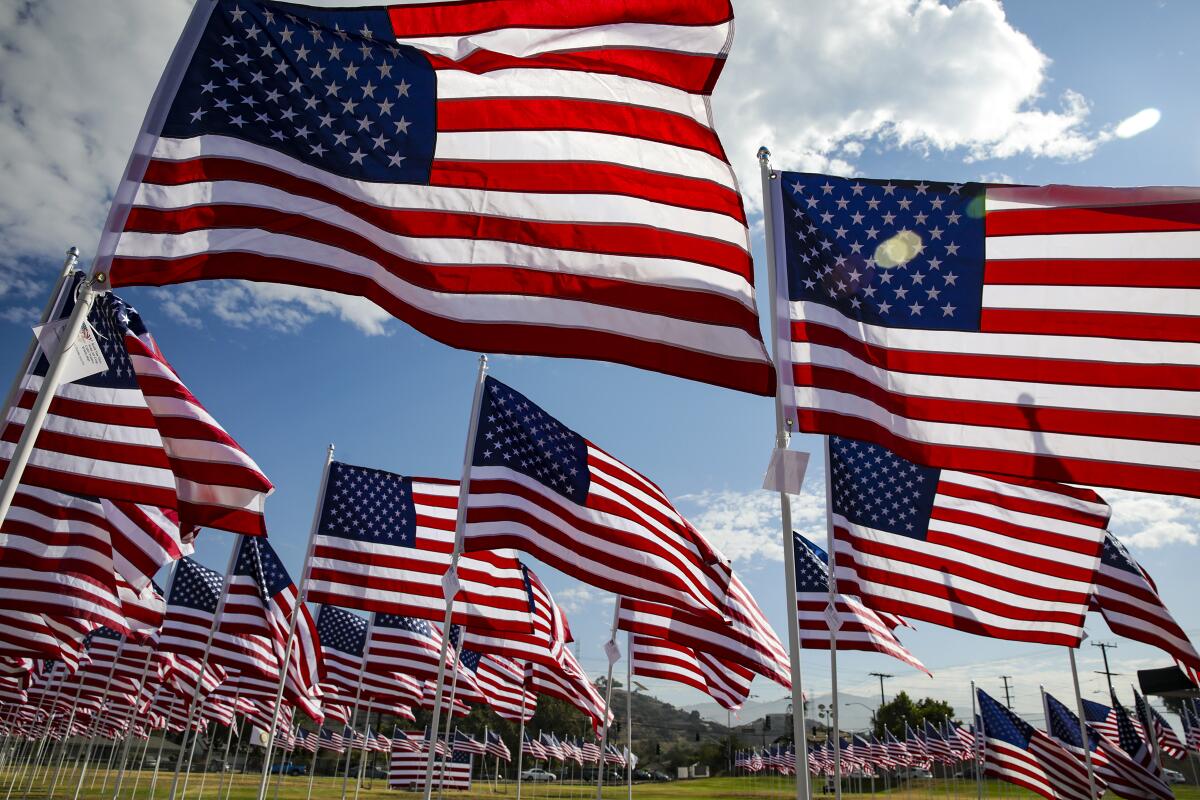Column: I’m officially reclaiming the U.S. flag from the fascists

- Share via
A few days ago, I stopped by CVS to buy cheap U.S. flag gear: a headband with two small flags glued to it, LED flag-themed glasses and a hat in red, white and blue. I wanted to see if I could rediscover my former enthusiasm for the flag.
Long before I was called “anti-American” (by devotees of the white demagogue), you could say I was a kind of patriot. The flag inspired in me a sense of pride.
But the flag has changed meaning for many of us. At the drugstore, I grabbed the patriotic items quickly and used self-checkout, hoping nobody would see. Though Donald Trump lost reelection nearly two years ago, the marketing master left a mark on the flag. Many Latinos and other people he scapegoated still recoil upon seeing it. It has become a stand-in for the GOP’s white nationalist agenda.
Opinion Columnist
Jean Guerrero
Jean Guerrero is the author, most recently, of “Hatemonger: Stephen Miller, Donald Trump and the White Nationalist Agenda.”
The hopeful sense in November of 2020 that we’d reclaimed the flag has died as the GOP deals blow after blow to hard-won equal rights, including women’s right to bodily autonomy. The euphoria of a spontaneous dance party I joined at a Los Feliz gas station on Nov. 7, 2020 — as Angelenos twerked with abandon amid U.S. flags — is long gone.
How can we celebrate Independence Day, with its flags and belligerent displays of patriotism, when so many in our communities feel terrorized by such rituals? I dumped the flag merchandise on my sofa and squinted. The stuff looked clownish and sinister, like the authoritarian himself. I picked up the LED flag glasses and put them on. Stepped in front of the mirror. Disturbed, I took them off.
How had Trump come to live inside this symbol I once believed represented me?

When I was 7 or 8, my mom bought me a T-shirt patterned like the flag. I wore it proudly, including on a visit to New York City when I posed on Ellis Island, with the Twin Towers in the background. The Statue of Liberty was spectacular, calling outcasts to our shores. My mother, who paid for medical school in Puerto Rico by enlisting in the National Health Service Corps, told me we lived in the “land of opportunity.”
A few years later, I watched the towers fall on TV from home in San Diego. President George W. Bush said we were attacked because “we’re the brightest beacon for freedom and opportunity in the world.” My mother bought U.S. flags for our house. I joined a large human flag formation at Qualcomm Stadium. I painted flags on my face and waved patriotic pompoms.
It wasn’t long before the fiction began to fray. I dreamed of becoming a journalist; early experiments in it taught me skepticism. Moreover, I’d always sensed a conflict at the heart of my mother’s patriotism. Where she cited a land of opportunity for all, I saw a Sisyphean topography for her.
In Greek legend, Sisyphus is doomed to roll a boulder up a mountain for eternity. My single mother seemed to be in an endless struggle for me and my sister. While raising us, she was also taking care of her elderly parents who had moved in with us from Puerto Rico. And she had developed a painful auto-immune disorder most common among women of color. Her license plate read: “CLIMING.”
The land of opportunity had a sinister side. Some people were condemned to climb forever.
Soon I learned Bush was using 9/11 as a pretext for war against innocent Muslims. I read about Mexicans dying at our militarized border. Later, as a reporter, I saw the bodies. I saw the U.S. guns displacing people in Latin America.
Then a Mexican-hating, Muslim-barring bully became president and raised a mob to attack the Capitol after he lost four years later. His Supreme Court paved a path to Gilead.
After all these horrors, how could the flag mean the same as it had before?
When I asked Myriam Gurba, a Long Beach activist and author of the coming essay collection “Creep,” whether she thought the flag was redeemable, she said: “Some things need to be burned.” I found myself agreeing with her.
U.S. protesters have a long tradition of burning the flag to demand change. It’s a form of protected speech. But I personally couldn’t do that. The flag has been at the center of so many courageous scenes in our history, not only shameful ones.
Later, while driving to see friends, I saw the small U.S. flags splayed on my car floor. They looked pitiful – like trashed, once-treasured mementos. The sight triggered a reflexive protectiveness.
I didn’t want to give up on the flag. Still, I had a hard time seeing past the mogul’s mark. I tossed my flag merchandise in my car, wanting it out of my place but unsure what to do with it.
I pulled up photos of the 2006 immigrant rights marches, when hundreds of thousands of Americans, mostly Latinos, demonstrated in more than 140 cities. The U.S. flag was everywhere.
It must have been nightmarish to the nativists reading Samuel Huntington’s mad ravings about Latinos as a threat U.S. identity: a sea of U.S. flags among Latinos. (The dreaded reconquista, accomplished!)
“It was a political maneuver and very strategic,” said Tomás Jiménez, a professor of sociology at Stanford University who studies American and racial identities. “You saw Latinos and immigrants in general claiming it as a symbol for their lives.”
Spanish-language radio host Eddie “El Piolin” Sotelo encouraged listeners to carry U.S. flags. “We wanted them to show that we love this country,” Sotelo told the Los Angeles Times. “Bringing the U.S. flag, that was important.”
In the flag-studded sea, Latinos saw a country that included them. The 2008 elections saw historic Latino voter turnout. Repurposed, the flag had a striking power: strengthening democracy.
“Mythology is more useful as a political tool than rationality,” the British Indian writer Rana Dasgupta told me. In those marches, pro-immigrant forces tapped into a powerful myth of American identity. However, Dasgupta argues, the political right lately shows the greater mastery of myth, fueling nationalism.
Democrats have shied away from boldly pro-immigrant policies and rhetoric. They’re the party of moderation, mythology’s kiss of death. But we’re a nation of immigrants. We can reimagine how inclusive a flag can be.
A Pew Research Center survey last year found that views on national identity here and in Western Europe are growing more inclusive despite xenophobic politics. As people meet more foreigners, their fear abates. And most Americans believe openness to the stranger “is essential to who we are.”
The U.S. flag should not belong to the fascists, who fail to grasp our strength. The flag should belong to the people carrying the boulder of this country on their backs.
They’ve been giving and giving and giving. They have every right to take back the flag.
More to Read
A cure for the common opinion
Get thought-provoking perspectives with our weekly newsletter.
You may occasionally receive promotional content from the Los Angeles Times.












